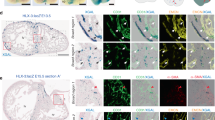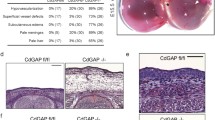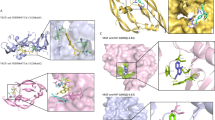Abstract
Akt is a pivotal signaling molecule involved in the regulation of angiogenesis. In order to further elucidate the role of Akt1 in blood vessel development, a tetracycline-regulated transgenic system was utilized to conditionally activate Akt1 signaling in endothelial cells to examine transcript expression changes associated with angiogenesis in the heart. Induction of Akt1 over the course of 6 weeks led to a 33% increase in capillary density without affecting overall heart growth. Transcript expression profiles in the hearts were analyzed with an Affymetrix GeneChip Mouse Expression Set 430 2.0, which represents approximately 45,000 cDNAs and ESTs. A total of 248 transcripts were differentially expressed between transgenic and control mice (fold change >/<1.8; false discovery rate < 0.1; P < 0.01). A subset of these differentially expressed transcripts included angiogenic growth factors, cytokines, and extracellular matrix proteins. More specifically, these transcripts included VEGF-receptor2, neuropilin-1, and connective tissue growth factor, each of which is implicated in blood vessel growth and the maintenance of vessel wall integrity. Furthermore, these factors may be involved in an autocrine-regulatory feedback system, one believed to promote vessel growth. Knowledge of these and other targets could be used to treat ischemic heart disease, a disease whose broad spectrum of manifestations range from patients with only effort-induced angina without myocardial damage, through stages of myocardial ischemia that are associated with reversible and irreversible impairment in left ventricular function, to states of irreversible myocardial injury and necrosis resulting in congestive heart failure (CHF).






Similar content being viewed by others
References
Carmeliet P (2000) Mechanisms of angiogenesis and arteriogenesis. Nat Med 6:389–395
Pugh CW, Ratcliffe PJ (2003) Regulation of angiogenesis by hypoxia: role of the HIF system. Nat Med 9:677–684
Helisch A, Schaper W (2003) Arteriogenesis: the development and growth of collateral arteries. Microcirculation 10:83–97
de Muinck ED, Simons M (2004) Re-evaluating therapeutic neovascularization. J Mol Cell Cardiol 36:25–32
Schaper W, Scholz D (2003) Factors regulating arteriogenesis. Arterioscler Thromb Vasc Biol 23:1143–1151
Yla-Herttuala S, Martin JF (2000) Cardiovascular gene therapy. Lancet 355:213–222
Dudek H, Datta SR, Franke TF, Birnbaum MJ, Yao R, Cooper GM, Segal RA, Kaplan DR, Greenberg ME (1997) Regulation of neuronal survival by the serine-threonine protein kinase Akt. Science 275:661–665
Franke TF, Kaplan DR, Cantley LC (1997) PI3 K: downstream AKTion blocks apoptosis. Cell 88:435–437
Songyang Z, Baltimore D, Cantley LC, Kaplan DR, Franke TF (1997) Interleukin 3-dependent survival by the Akt protein kinase. Proc Natl Acad Sci USA 94:11345–11350
Gerber H-P, McMurtrey A, Kowalski J, Yan M, Key BA, Dixit V, Ferrara N (1998) Vascular endothelial growth factor regulates endothelial cell survival through the phosphatidylinositol 3′-kinase/Akt signal transduction pathway: Requirement for Flk-1/KDR activation. J Biol Chem 273:30336–30343
Fujio Y, Walsh K (1999) Akt mediates cytoprotection of endothelial cells by vascular endothelial growth factor in an anchorage-dependent manner. J Biol Chem 274:16349–16354
Fulton D, Gratton JP, McCabe TJ, Fontana J, Fujio Y, Walsh K, Franke TF, Papapetropoulos A, Sessa WC (1999) Regulation of endothelium-derived nitric oxide production by the protein kinase Akt. Nature 399:597–601
Dimmeler S, Fleming I, Fisslthaler B, Hermann C, Busse R, Zeiher AZ (1999) Activation of nitric oxide synthase in endothelial cells by Akt-dependent phosphorylation. Nature 399:601–605
Scotland RS, Morales-Ruiz M, Chen Y, Yu J, Rudic RD, Fulton D, Gratton JP, Sessa WC (2002) Functional reconstitution of endothelial nitric oxide synthase reveals the importance of serine 1179 in endothelium-dependent vasomotion. Circ Res 90:904–910
Sun JF, Phung T, Shiojima I, Felske T, Upalakalin JN, Feng D, Kornaga T, Dor T, Dvorak AM, Walsh K, Benjamin LE (2005) Microvascular patterning is controlled by fine-tuning the Akt signal. Proc Natl Acad Sci USA 102:128–133
Shiojima I, Sato K, Ito M, Schiekofer S, Liao R, Colucci W, Walsh K (2005) Disruption of coordinated cardiac hypertrophy and angiogenesis contributes to the transition to heart failure. J Clin Invest 115:2108–2118
Skurk C, Maatz H, Kim HS, Yang J, Abid MR, Aird WC, Walsh K (2004) The Akt-regulated forkhead transcription factor FOXO3a controls endothelial cell viability through modulation of the caspase-8 inhibitor FLIP. J Biol Chem 279:1513–1525
Benjamini Y, Hochberg Y (1995) Controlling the false discovery rate: a practical and powerful approach to multiple testing. J R Stat Soc B 57:289–300
Takahashi T, Kalka C, Masuda H, Chen D, Silver M, Kearney M, Magner M, Isner JM, Asahara T (1999) Ischemia- and cytokine-induced mobilization of bone marrow-derived endothelial progenitor cells for neovascularization. Nat Med 5:434–438
Llevadot J, Murasawa S, Kureishi Y, Uchida S, Masuda H, Kawamoto A, Walsh K, Isner JM, Asahara T (2001) HMG-CoA reductase inhibitor mobilizes bone-marrow derived endothelial progenitor cells. J Clin Invest 108:399–405
Miao HQ, Lee P, Lin H, Soker S, Klagsbrun M (2000) Neuropilin-1 expression by tumor cells promotes tumor angiogenesis and progression. Faseb J 14:2532–2539
Miao HQ, Klagsbrun M (2000) Neuropilin is a mediator of angiogenesis. Cancer Metastasis Rev 19:29–37
Fuh G, Garcia KC, de Vos AM (2000) The interaction of neuropilin-1 with vascular endothelial growth factor and its receptor flt-1. J Biol Chem 275:26690–26695
Kureishi Y, Luo Z, Shiojima I, Bialik A, Fulton D, Lefer DJ, Sessa WC, Walsh K (2000) The HMG-CoA reductase inhibitor simvastatin activates the protein kinase Akt and promotes angiogenesis in normocholesterolemic animals. Nat Med 6:1004–1010
Fujisawa H, Takagi S, Hirata T (1995) Growth-associated expression of a membrane protein, neuropilin, in Xenopus optic nerve fibers. Dev Neurosci 17:343–349
Kitsukawa T, Shimono A, Kawakami A, Kondoh H, Fujisawa H (1995) Overexpression of a membrane protein, neuropilin, in chimeric mice causes anomalies in the cardiovascular system, nervous system and limbs. Development 121:4309–4318
Kitsukawa T, Shimizu M, Sanbo M, Hirata T, Taniguchi M, Bekku Y, Yagi T, Fujisawa H (1997) Neuropilin-semaphorin III/D-mediated chemorepulsive signals play a crucial role in peripheral nerve projection in mice. Neuron 19:995–1005
Takashima S, Kitakaze M, Asakura M, Asanuma H, Sanada S, Tashiro F, Niwa H, Miyazaki Ji J, Hirota S, Kitamura Y, Kitsukawa T, Fujisawa H, Klagsbrun M, Hori M (2002) Targeting of both mouse neuropilin-1 and neuropilin-2 genes severely impairs developmental yolk sac and embryonic angiogenesis. Proc Natl Acad Sci USA 99:3657–3662
Fons P, Herault JP, Delesque N, Tuyaret J, Bono F, Herbert JM (2004) VEGF-R2 and neuropilin-1 are involved in VEGF-A-induced differentiation of human bone marrow progenitor cells. J Cell Physiol 200:351–359
Parikh AA, Fan F, Liu WB, Ahmad SA, Stoeltzing O, Reinmuth N, Bielenberg D, Bucana CD, Klagsbrun M, Ellis LM (2004) Neuropilin-1 in human colon cancer: expression, regulation, and role in induction of angiogenesis. Am J Pathol 164:2139–2151
Seeger FH, Haendeler J, Walter DH, Rochwalsky U, Reinhold J, Urbich C, Rossig L, Corbaz A, Chvatchko Y, Zeiher AM, Dimmeler S (2005) p38 Mitogen-activated protein kinase downregulates endothelial progenitor cells. Circulation 111(9):1184–1191
Bradham DM, Igarashi A, Potter RL, Grotendorst GR (1991) Connective tissue growth factor: a cysteine-rich mitogen secreted by human vascular endothelial cells is related to the SRC-induced immediate early gene product CEF-10. J Cell Biol 114:1285–1294
Kireeva ML, Latinkic BV, Kolesnikova TV, Chen CC, Yang GP, Abler AS, Lau LF (1997) Cyr61 and Fisp12 are both ECM-associated signaling molecules: activities, metabolism, and localization during development. Exp Cell Res 233:63–77
Surveyor GA, Brigstock DR (1999) Immunohistochemical localization of connective tissue growth factor (CTGF) in the mouse embryo between days 7.5 and 14.5 of gestation. Growth Factors 17:115–124
Igarashi A, Hayashi N, Nashiro K, Takehara K (1998) Differential expression of connective tissue growth factor gene in cutaneous fibrohistiocytic and vascular tumors. J Cutan Pathol 25:143–148
Shimo T, Nakanishi T, Nishida T, Asano M, Kanyama M, Kuboki T, Tamatani T, Tezuka K, Takemura M, Matsumura T, Takigawa M (1999) Connective tissue growth factor induces the proliferation, migration, and tube formation of vascular endothelial cells in vitro, and angiogenesis in vivo. J Biochem (Tokyo) 126:137–145
Acknowledgement
S. Schiekofer and K. Belisle were supported by LFS Baden-Württemberg. S. Schiekofer and K. Belisle contributed equally to this work.
Author information
Authors and Affiliations
Corresponding author
Electronic Supplementary Materials
Rights and permissions
About this article
Cite this article
Schiekofer, S., Belisle, K., Galasso, G. et al. Angiogenic-regulatory network revealed by molecular profiling heart tissue following Akt1 induction in endothelial cells. Angiogenesis 11, 289–299 (2008). https://doi.org/10.1007/s10456-008-9112-6
Received:
Accepted:
Published:
Issue Date:
DOI: https://doi.org/10.1007/s10456-008-9112-6




